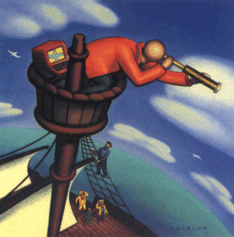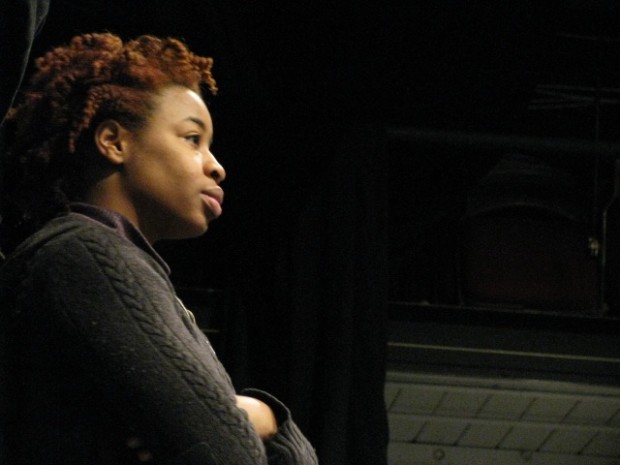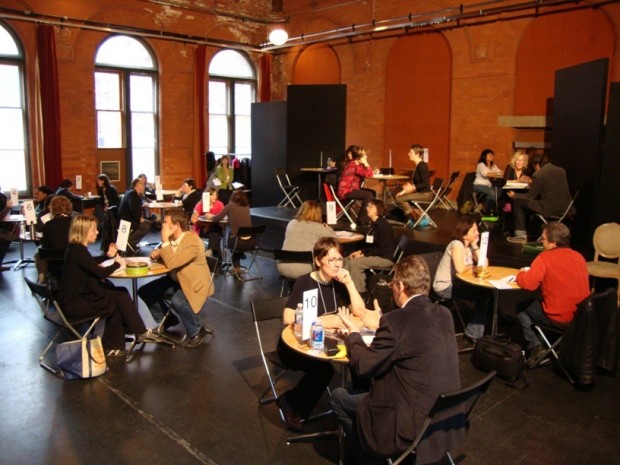Original theatrical creation of the decade?
Best play of the decade? Possibly.
Best play that hit Toronto in 2009? Certainly.
Best play of the decade? Possibly.
Best play that hit Toronto in 2009? Certainly.
 Over on The Next Stage you can find the final round in the Theatrosperical State of the Nation these two websites have been engaged in at the end of 2009. Last chance for any and everyone to leave a comment, question, opinion, or just straight up hyperbole in response.
Over on The Next Stage you can find the final round in the Theatrosperical State of the Nation these two websites have been engaged in at the end of 2009. Last chance for any and everyone to leave a comment, question, opinion, or just straight up hyperbole in response.
At the end of today the whole conversation will be scooped up and sent off to the people at Summerworks (with some editing) as an article for Works magazine. When else are you going to have a chance to leave a comment in digital-land with the chance it will be reprinted and distributed in a classy paper physical form?
You can read Round 1 here, Round 2 here, and Round 2.5: a Kris Joseph Intermezzo here.

Africa Trilogy assistant director Deanna Downes has been ruminating on the project from her secret lair in Philadelphia.
Africa Trilogy Set for a Smooth Landing in The States?
by Deanna Downes
David Mamet’s new play Race is playing on Broadway. A New York Times review calls it “a play that examines the self-consciousness that descends on American white people when they talk about, or to, black people.”
Fela, a play about the revolutionary creator of Afro-pop, Fela Kuti, is also on Broadway. When talking about his production of Fela, director Bill T. Jones says Fela’s life brings about, “questions like creativity, transgression, rebellion, sensuality, history, race, power.”
It would appear, the theatrical runways are being paved for a smooth landing of this multi-national but Canadian birthed trilogy about Africa and the West.

Image by Paul Ingles licensed under Creative Commons 2.0
This week praxistheatre.com was voted the #1 Culture and Literature Blog in Canada in the 2009 Canadian Blog Awards.
We are super-happy about this and really appreciate everyone who participates with the company digitally and in reality.
Thank you in particular to these people:
Happy Holidays to all!
Michael Wheeler
Editor
praxistheatre.com
by Lindsay Schwietz
When Rina Fratticelli’s report came out in 1982 revealing the amount of women in power positions in Canadian theatre to be shockingly low, the gender inequality issue was exposed. Yet, twenty-seven years later the PACT Equity in Canadian Theatre report on gender shows that very little has changed. In PACT theatres in the 2008-2009 season, women accounted for 29% of the artistic directors, 36% of the working directors and 29% of the produced playwrights. Primarily men are still running theatre companies across Canada. And the larger the theatre company, the less women in artistic leadership positions.
This is true despite the fact that there are more women in theatre schools and more women in audiences. According to the same report, almost 60% of the theatre-going audience in Canada is thought to be female and women account for 68% of student enrolment in the performing arts, communication and technologies fields. Yet, these percentages don’t match the employment opportunities for women.
Why is this happening? Why has very little changed in over twenty years? And what is being done about it? Are we going to be looking at these same statistics twenty years from now?
Kelly Thornton is Artistic Director of Nightwood Theatre, and co-head of the national advisory committee of Equity in Canadian Theatre: The Women’s Initiative, a group of activists whose aim is to formally investigate the status of women in Canadian theatre and develop plans to change existing barriers. She believes the lack of females is not something done on purpose, but created through subconscious choices by the male artistic directors that run 71% of the theatres in Canada.
“I don’t think they’re actually saying ‘we’ve got to keep women out’ – I just think there is a gender bias to the way we program seasons. I always use the analogy of a man and a woman walk into a bookstore. The two will both buy a novel and they will come out with totally different novels. And it’s based on their gender. Think of a male and a female AD – they’re gravitating towards stories that speak to them. And often that has to do with gender.”
Thornton stresses this is not an attack on men, or male AD’s. It’s about subconscious choices. “Who better to direct Bob’s play than Bill. It’s the domino effect.” Yet, when the primary ticket buyer is female, why is this not questioned more often? Why do women just accept watching male stories, directed by men, as the norm?
Many of these issues were discussed last month as 150 female directors from across Canada came to Toronto to take part in the week-long Directors Summit at the 4×4 Festival, sponsored by Nightwood Theatre. A mix of established and emerging directors participated in master classes, workshops, panel discussions, and seminars. With the statistics on the lack of gender balance being released this year, an event such as this is not only an opportunity for networking of female directors and theatre workers, but also a step towards solidarity in the face of these shocking numbers.

Nightwood Theatre's Directors Summit included a Marketplace for emerging directors to meet face-to-face and network with established professionals.
One of the main events of the summit was the Marketplace, where emerging female directors and artistic directors from across the country met in a speed-dating atmosphere. It allowed emerging directors to meet face-to-face and network with established professionals. This also ties in with The Canadian Women Directors Catalogue: a comprehensive list of Canadian Women Directors, an initiative by Nightwood Theatre currently in development, which will be sent out to theatres across Canada. The artistic directors who receive this catalogue will now have faces to put to names. Thornton hopes the experience will really get artistic directors “thinking about how to actually tangibly effect change by being conscious when they’re programming”.
Perhaps this is the key, as Thornton suggests, to effecting change: “This is a conscious-raising effort on my part. This is just about staying awake to the issues. When you’re making your season choices, always look at your roster… and try to include the other half of the planet. Have the grace to acknowledge the track record hasn’t been good in the past and pay more attention to it in the future….The culture will balance itself if we all just admit there is an issue and then tangibly take it on in our own way. Think globally, act locally. Do one thing per season that slightly changes the way you work,” says Thornton.
This is not only happening in Canada. In June of this year, Sphinx Theatre Company in Great Britain held the conference on gender Vamps, Vixens and Feminists: The Elephant in the Room. Among discussions of gender equality, were statistics from a 2006 Women in Theatre Survey, revealing that only 17% of playwrights produced in Britain were female, and only 23% of productions were directed by women.
In America, there has also been a lack of female directors and playwrights. In April of this year, Emily Glassberg Sands submitted to Princeton University a report entitled: Opening the Curtain on Playwright Gender: An Integrated Economic Analysis of Discrimination in American Theater. This report examined gender bias against female playwrights in the United States. Sands showed through experiments that, among other very interesting results, artistic directors believe that a script written by a female pen-name will make less money and be of lower quality than the same script with a male name as the playwright. Sands also mentions in her report that on Broadway in the 2008/09 season only 12.6% of the plays produced were written by women.
Would it actually affect the economic prospects of the play if it’s written or directed by a woman, telling female stories? In her opening remarks at the Kick Start Reception of the Directors Summit, Shaw Festival Artistic Director Jackie Maxwell spoke of her experience: “I did this, I got a whole bunch of female directors in and I dug up all the female playwrights from that time period, and I just want to let you know that the sky didn’t fall, that the audiences didn’t go away, that nobody actually knew the difference. The success was still the same.”
If we are all conscious of what choices we make as theatre practitioners, and if we are all aware of these inequalities, the small changes will become big changes. As Mary Vingoe, inaugural Artistic Director of the Magnetic North Festival, said while facilitating a panel on Women Directing in Canadian Theatre, “hopefully in ten years we won’t have to be having this same discussion.”
Guest Post by Simon Ogden of Vancouver’s The Next Stage – second in a series…
Greetings, my fellow Canadians (and theatre fans around the world), my name is Simon and I’m a blogging advocate. Which basically means I’m enamored with the potential power of internet self-publication as a business tool. I’ve been using it to much success in the past few years, and so I’m officially convinced of both its practicality and potency. Mike asked me if I would care to elaborate here (and over on my own blog), and having just publicly declared myself a blogging advocate, I had really no choice. We’re going to ping-pong a conversation about the Canadian theatrosphere spurred by Michael Rubenfeld over at Summerworks between us for a while, and see where it goes. We would be delighted if you would join the conversation, if you do your comments may be published in the hard-copy compilation in Works magazine. And we hope you do.
Preamble over, on to the business at hand…
______________________________________________________________________
CLICK HERE TO READ ROUND 1 OF THIS CONVERSATION
(it will really help to understand what follows)
thenextstage
Thanks M-Dub (if no one calls you that they should, it’s dope. S.O. just sounds like a shrug). It’s a topic that I have a peculiar amount of verve about, so this should be a good conversation. And hopefully an inspiring one.
“While the digital revolution hasn’t changed theatre much…”
Four years ago I made a prediction that the rise of the blogosphere would radically change theatre in Canada. Change it in the way practitioners thought about the way they produce work, in the way resources were shared and in the dramatic expansion of the audience base. At this point I’m prepared to say that I wasn’t altogether wrong in this prediction, but I would certainly excise the word “radically” from that sentence. The internet is proving to be a tough monster to wrangle for our particular discipline, the growth of the Canadian theatrosphere so far has proven to be relatively slow. That is, relative to tech-centric arts communities; photographers and digital artists have a surfeit of chatter to engage with on line.
It’s essential here at the outset that we define what we mean by ‘the theatrosphere’, and what exactly it means when it uses the term ‘theatre blogging’. There are a lot of active theatre blogs that aren’t really part of the theatrosphere, these are self-contained sites – usually company blogs – that post solely on their own business. These are marketing sites, and have little or no interaction with the rest of the industry online. The theatrosphere uses social media for two distinct agendas – and yes, sometimes those agendas get muddied – to market our work, and to engage in dynamic, real-time conversation with our fellows. If you’re not connecting across borders, you’re not part of the conversation. This, in a nutshell, is the great hope of the core concept of theatre blogging: to create an inter-connected, self-supported, crowd-sourcing resource hub that anyone can plug into.
To put it another way, the theatrosphere is a big ol’ cocktail party that’s always running. It’s a klatch full of a crazy array of personalities, from brash and irritating to gentle and wise. But always highly opinionated, and therein lies its true promise. I hear young theatre artists constantly complaining about how cliquey an industry independent theatre is, about how tough it is to break into ‘the scene’. What they’re talking about is information sharing; where does your audience come from, what is it about your process that works for you, how do you get to know the critics? Etc, etc. I don’t believe that we’re cliquey at all, actually, we’re an art form that does its work in little groups in little dark rooms that require a certain bond of trust to get the most from the process itself. We’re not snobby, we’re just busy. And we’d all like to meet regularly to socialize and network, but who has the time? Making the time to make connections is the next stage in the evolution of the indie theatre industry, and the internet offers the most economic solution to time-manage our networking and marketing efforts.
And yet we still lack a true National connectivity. Or even a regional one. I have amazing connections in my niche across the country (not even counting the inspiration and assistance I get from theatre bloggers in the US – which has a busier if not a more comprehensive blog community – and the rest of the world), but the actual amount of theatre practitioners walking into this cocktail party is shockingly small. Engagement is so easy to measure on the blogosphere, because the platforms themselves tell you when someone is talking to you or about you. There is still only a handful of engaged theatre bloggers across the entire country. I know of exactly zero East of the Rockies until you hit Toronto, then a couple in Ottawa and…that’s pretty much it. Where are the theatre bloggers, Canada? Edmonton? Winnipeg? What’s up?
As for the question of comics marketing themselves on social media better than theatre, well, maybe. But it’s kind of apples and oranges, stand-up comedy is YouTube friendly, it fulfils it’s core objective – to make you laugh – on the computer almost as much as it does live. But theatre’s objectives – to make you feel, connect, respond viscerally – just don’t translate that well to 2D. Televised theatre looks like crap, unless it’s shot well and then it suffers the iniquity of being mutated into a different medium. On top of that, the public at large understands stand-up, it’s something they already want, while they still mostly think of us as tight-wearing, Elizabethan-blathering bores. So we have to get mighty creative with how we sell ourselves on the web. It’s happening, there are some wonderful explorations in digital marketing going on in our corner of art, but it is truly in its infancy. To grow it’s going to need a movement. We have to find some way of selling the power of blogging to the world of theatre, to create a true National presence. To brand independent theatre as a mighty, united force to be reckoned with. And then the people will come.
MK
Simon, I certainly agree with what you say in terms of comedy being a much friendlier video medium. I haven’t figured out any way to create a video to promote a play reading festival so if someone has ideas I’d love to listen.
I know for me that I’m a lot less engaged in blogs, even my own, because of needing more time away from the computer and from Twitter. Twitter’s much less time consuming way of receiving and conveying information. I’m not sure if that says something about me or if that’s a trend in general. The more growth there is, the more overwhelmed I feel by it all.
I’m curious to see where this experiment between the two of you leads. I’m one of those lucky people who have met both of you and have a ton of respect for how the two of you manage to stay engaged in the blogosphere on top of all the other things you do.
thenextstage
Twitter’s really got you, eh? I totally get it, there’s been a real waning of the blogoshpere since twitter tipped. And that’s probably a good thing, full posts tend to be fewer and farther between, but the quality has escalated.
Another tick in the win column for twitter.
There actually were a ton of theatre co’s here that had never blogged that jumped on twitter, it’s my sincere hope that it proves a gateway to full blogging. Because I’d really love to hear about their work from the artist’s perspective.

praxistheatre.com is one of five blogs in the Culture and Literature category that have advanced to the final round round of voting in the 2009 Canadian Blog Awards.
We need your help to come out on top. It only takes about 10 seconds to vote. The ranked ballot allows you to vote for as many blogs as you want.
Best of luck to our competition: Mouse-traps and the Moon, North By East West (NxEW), Book Mine Set, and Quick Brown Fox. Make sure to check out all four of these great portals to increased understanding of and interaction with Canadian culture.
As first reported in The Toronto Star, The Harold Green Theatre Company has pulled $50,000 in funding seven weeks befrore the curtain of the Convergance Theatre production of Yichud/Seclusion at Theatre Passe Muraille, after a major funder got a hold of the script and decided “the material might be misconstrued”.
In a scathing article on NOW Daily yesterday, Susan G.Cole called into question the ability of the company to remain artistically relevant in the wake of that decision:
I want to be clear. A Jewish theatre has the right to program material that it believes meets its mandate. Similarly, a gallery has the right to curate what it believes is consistent with its values – and I’ve said as much with relation to the Koffler’s decision to abandon Katz
But if Jewish artistic institutions narrow their vision in such a way that Jewish artists cannot produce thoughtful work probing the situation in Israel or in Orthodox Jewish homes or anywhere inside the Jewish community, exactly what kind of art do they think is going to get produced. And do the folks at Harold Green really think that, after this debacle, Jewish playwrights who matter will even consider affiliating with the theatre?
Maybe it’s time for Jewish theatre artists to establish the company we deserve – the Harold Green Jewish Theatre isn’t cutting it.
Next up for the Harold Green: a December 15th deadline for playwrights to submit to “In The Beginning: A Jewish Playwright Festival” which “aims to open the door for groundbreaking Jewish voices that challenge the Jewish perspective.” Note to playwrights – groundbreaking and challenge may not have the meaning you are used to in this context.
Meanwhile, Passe Muraille and Convergence have managed to salvage their co-production with some amazing fundraising, but they had to cut a full week of rehearsals to make the new smaller budget fly. They’re still fundraising in an effort to get back that key week you need to make good art great.
You can make a donation though Canada Helps here.
(Under Fund/Designation select: Help Convergence Theatre)

Councillors sat at these desks to pass the sign bylaw 25 -16 before investigating how the flux capacitor had caused the warp drive to go offline
By Michael Wheeler
Yep, that’s right: Toronto has a new sign bylaw and it’s a pretty good one. A ten-year battle by public space advocates was passed by an even wider margin they hoped for. It will create more than $10 million for the City of Toronto annually. Their success will likely go down as a famous and glorious moment in grassroots political organizing in Toronto, and a good story for the kids about what you can accomplish with a huge dose of sticktoitiveness and a flawlessly executed and integrated social and mainstream media campaign.
The news for arts funding advocates was less rosy. Even though the City of Toronto staff report recommended directing the revenue to arts funding, the bylaw was passed without this stipulation and there are many assurances, but no guarantees, that some of the funds will be earmarked for art. Councillor Rob Ford stated explicitly that he believed the monies would not end up being used for arts funding.
Ford was emblematic of the virulent anti-artist bias that still exists within City Hall. Attacking artists in attendance, referring to them as “freeloaders”, he questioned their ability to simultaneously be employed and participate in democracy by attending City Hall. Councillor Minnan-Wong went as far to suggest that artists are not real people – hoping to ensure that the funds would never see any arts groups going instead to, “real people, real communities”.
Cheekiest moment of the debate went to Councillor Adam Vaughan for his motion that the City of Toronto congratulate Knaan for being chosen to perform in front of hundreds of millions with his 2010 World Cup song and for generally becoming a major world superstar who is still engaged with his community. Counsellor Vaughan was also quick to point out that Knaan had been the recipient of municipal arts funding when he was an emerging artist in Etobicoke – the region Rob Ford represents.
Net result: This is a great opportunity for artists to take the high road and and strengthen relationships with their allies. Clearly this bylaw would never have passed with out artists and arts-based activism. Clearly the arts should see some of this money – but what about the rest of it? After $1.4 Million of the tax is used to pay for proper enforcement of the new sign bylaws, what will the other $9 million go to? Obviously the Toronto Arts Council is a good start, all of it would double what TAC gives out in a given year, which seems unrealistic in a city with a cost-prohibitive transit system.
What are the other things that make a city beautiful? I would go with 1) less hunger 2) more affordable housing 3) cleaner air/better cycling routes. Someone else might pick something else, but I bet most artists would be in the same ballpark. Arts activists are now in a unique position to increase their own funding and that of their allies and partners in making a truly beautiful city.
This is possibly the only way to prove ideologues like Ford and Minnan-Wong wrong: By showing we understand we are part of a grander scheme for society, one that incorporates many factors that work in tandem with one another that make our communities a better place to live. We are even capable of sharing resources amongst ourselves – because it is essential to each element that we all thrive. Real people and communities are complicated and multi-dimensional that way.
Recent Comments